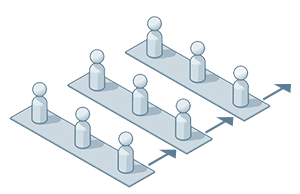When defining a generative design study, you can change the generation settings if desired.
In most cases, the default settings are sufficient for generating design alternatives.
Access: During the Create Study workflow, the Define Study dialog displays after you select the study type. Select a method. Go to the Generation Settings section of the dialog, and expand it if needed.
In this topic
Population size
This setting applies only when the study method is Optimize.
The genetic algorithm starts with an initial population from which selection occurs. Each individual in the population is a potential solution to the design problem. Each individual has a unique set of features that serve as the genes to evolve the design.

To ensure that your study evolves to find the best solution, consider the following tips:
- At least some of the genes need to have variable values.
- The population size must be large enough. A sufficient size depends on the project, the amount of genes, and the range of variable values. A rule of thumb is to set the population size to at least three times the number of inputs.
- If the outcomes don't start to converge to an answer, try increasing the population size.
Generations
This setting applies only when the study method is Optimize.
A genetic algorithm is a population-based optimization. Population-based approaches maintain and improve multiple candidate solutions, often using population characteristics to guide the search. Each round of the optimization processed in the genetic algorithm is called a generation. When you set the generation value to 40, the process of selection, cross-over, and mutation happens 40 times for each population of 40 designs. (Read more on Wikipedia.)

When you set Generative Design to run 30 generations, for example, the optimization process is repeated until one or a combination of the following conditions is met:
- The fixed number of generations has been reached.
- The highest ranking solution's fitness has reached a plateau, such that successive iterations no longer produce better results.
- You manually stop the process.
Number of outcomes
This setting applies when the study method is Randomize or Like This.
How many outcomes (design alternatives) do you want to generate?
More outcomes allow you to explore a wider set of alternatives but will take longer to complete. Fewer outcomes will generate more quickly but won't explore possible alternatives as thoroughly.

Seed
This setting applies when the study method is Optimize or Randomize or Like This.
A seed is a value that provides a starting point for the algorithm. If you keep the same seed and then do another run with the same inputs, you should get the same outcome. If you change the seed, you will get different results.
How many starting points (seeds) do you want to use when generating outcomes?
For more information, see Generative Design Primer: Genetic Algorithms.

About genetic algorithms
Generative Design uses the NSGA-II optimization algorithm (a type of genetic algorithm). Genetic algorithms can generate high-quality solutions to optimization and search problems by relying on bio-inspired operators such as mutation, cross-over, and selection. See Generative Design Primer: What is a Genetic Algorithm?